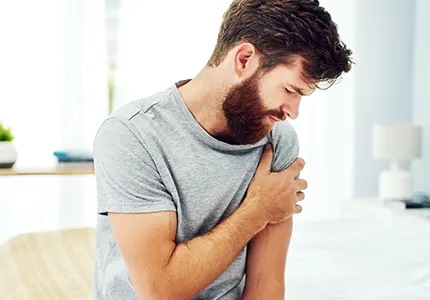- Herniated Disc
- Nerve Pain
- Lower Back Pain
- Abdominal Pain
- Neck Pain
- Sciatica
- Spinal Stenosis
- Pinched Nerve
- Neuropathy
- Joint Pain
- Complex Regional Pain Syndrome
- Facet Joint Pain
- Facet Syndrome
- Spinal Arthritis
- Degenerative Disc Disease
- Fibromyalgia
- Myofascial Pain Syndrome
- Phantom Limb Pain
- Cancer Pain
- Headaches and Migraines
Service Reviews
- A.B. / Google
"Very friendly and professional staff. On my first visit Dr Nguyen was prepared with a plan help relieve my SI joint pain."
What Is Joint Pain?
Joints are the connection between bones and allow for movement and for varying our body position. Joint pain may be caused by injury to the tissues that make up the joint. Large and small joints can hurt when there is injury to smooth cartilage that lines the joint, the connecting ligaments, or tendons. Injury or inflammation to the surrounding tissues of the affected joint or joints can limit movement and cause pain, even during rest. Also referred to as arthralgia, joint pain can be a manifestation of an inflamed joint that may last a few weeks or longer. Our goal is to reduce pain and inflammation while restoring function to the affected joint.

TYPES OF JOINT PAIN
Arthritis
The term "arthritis" means inflammation of a joint, the area of connection between two bones. The most common cause is osteoarthritis that causes degenerative changes in the cartilage (material that cushions joints) within the joints. Another form is rheumatoid arthritis that can be seen in any age and is inflammation of the sac which contains the fluid within the joint (synovial fluid). Symptoms of arthritis include swelling, tenderness, redness, and warmth in the affected joint(s), "popping" of joints, bone deformities, pain worse in the morning that improves with movement, and joint stiffness. Treatment for osteoarthritis includes rest, exercise, maintaining a healthy weight, NSAIDs, and use of heat and ice. Rheumatoid arthritis treatment typically requires management with a rheumatologist.
Hip Pain
Hip pain can occur due to injury, infection, tumor, but most commonly, arthritis (inflammation). The pain can arise from the femur (leg bone), pelvis, ligaments, cartilage, surrounding muscles, or pathology in the low back affecting a lumbar spinal nerve. Symptoms include pain that may radiate into the groin, stiffness, instability of the joint, or muscle spasms. Treatment depends on the underlying cause but typically includes rest, NSAIDs, crutches, physical therapy, chiropractic adjustments, analgesics, steroid injections, and possible surgery.
Knee Pain
Knee pain can occur due to injury, infection, tumor, but most commonly, arthritis. The pain can stem from the bone, the ligaments and tendons that help hold the knee together, or the bursa and menisci that help provide cushioning of the joint. Symptoms can include knee joint instability, pain, swelling, redness, and stiffness. Treatment depends on the underlying cause but typically involves rest, NSAIDs physical therapy, steroid injections, and possibly surgery.
Sacroiliac (SI) Joint Pain
The SI joints are where the bottom portion of the spine, the sacrum, connects to two of the bones that make up the pelvis, iliac bones, which lie on each side of the spine. The SI joints are relatively immobile being held in place by ligaments and support the majority of the weight of the spine so they are frequently stressed. Chronic stress can lead to arthritis of the SI joints which in turn, causes pain. The SI joints can also be painful during pregnancy when added stress is applied to them due to the relaxation of the ligaments that help hold the SI joints stable as the body prepares for childbirth as well as the added weight incurred during pregnancy. Unequal leg lengths may also place added stress on the SI joints causing pain. Symptoms typically include low back pain that is worsened with standing or walking and may or may not include pain into the thighs or groin. Treatment includes NSAIDs, physical therapy, chiropractic adjustments, exercise such as yoga or Pilates, and steroid injections into the joint.
